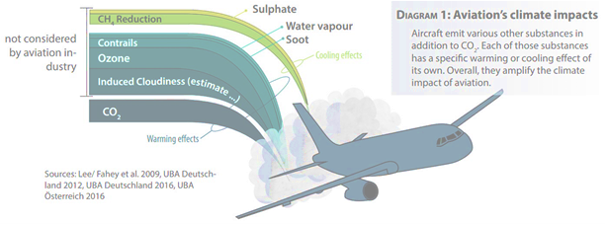Why Offset “Comprehensively”?
It is well known that carbon dioxide (CO2) emissions contribute to climate change via a greenhouse gas effect. The effects of CO2 are relatively well-understood and regulatory measures continue to emerge to address or cap CO2 emissions. However, recent research has shown that only one-third of the climate impact of aviation actually comes from CO2, the remaining two-thirds comes from other emissions or impacts.
What are the other impacts?
In addition to CO2, aircraft emit NOx, sulfates, water vapor, aerosols, and soot. NOx contributes to ozone increases and methane reduction, while aerosols and soot create the foundation for water vapor to freeze and form contrails. There are cooling and warming effects from these emissions, but due to their emission at high altitude, overall they result in a high net warming effect, three times that of CO2 alone.
Radiative Forcing Index & Global Warming Potential
Despite not being perfectly understood, the impact of these other emissions can be compared to that of CO2 through the use of a radiative forcing index. Effective Radiative Forcing represents the warming impact over a certain timescale which can be normalized to CO2 to create a Radiative Forcing Index (RFI) and comparative Global Warming Potential (GWP). Using the GWPs, the impacts of these other emissions can be converted into an equivalent amount of CO2 (CO2e). In effect, looking at how much CO2 would need to be emitted to create the same impact as the emission being measured.
Contrails warm the environment?
One of the largest impacts actually comes from the formation of high-altitude contrails. Contrails can create cirrus clouds, both of which are known as aircraft-induced cloudiness (AIC). Contrails create a more translucent cloud allowing some sunlight through, but trapping heat just like greenhouse gases. An individual contrail is relatively short-lived, lasting hours to days depending on certain atmospheric composition – for example: high humidity can make them more persistent. It is the constant air traffic leaving contrails or certain atmospheric conditions that create more consistent and widespread cirrus cloudiness that leads to their large impact.
Aircraft-Induced Cloudiness (AIC) makes up a majority of the Radiative Forcing (RF) impact from aviation with most of that coming from contrail-induced cirrus clouds. Source: (Kärcher, 2018)
Depending on the cloud’s thickness (optical depth), it may reflect some sunlight during the day, but overall still results in a warming effect from its reflection of radiated heat back to earth at night. Moreover, contrails can exist so finely that we cannot see them, while still contributing to a warming impact.
Contrail Clutter over Georgia. Credit: NASA
Mitigation
Using more advanced climate modeling and forecasting, we could predict “climate sensitive” regions in the atmosphere – regions with certain ozone composition or areas susceptible to contrail formation. With those forecasts in place, air traffic control could route aircraft to avoid climate sensitive regions. Just a 0.5% increase in fuel burn (& CO2 emissions) could result in a 25% decrease in climate impact. However, there is unlikely to be new climate routing until there is a financial incentive to account for non-CO2 impact, a refined understanding of those impacts, and an ability to model and forecast complex atmospheric conditions.
More research is needed, but reducing night flights and cruising at lower altitudes may also aid in reducing non-CO2 emissions.
New sustainable fuels also address non-CO2 emissions with many fuels burning cleaner and thereby producing less contrail-forming soot. Electrification and the use of fuel cells could eliminate these in-flight emissions altogether.
The bottom line
Focusing only on CO2 emissions is not sufficient: “to halt aviation's contribution to global warming, the aviation sector would need to achieve net-zero CO2 emissions and declining non-CO2 radiative forcing […] neither condition is sufficient alone” (Lee et al., 2020) We must address both CO2 and non-CO2 emissions if we are really to think about neutralizing aviation’s impact on the environment.
Next Steps
The goal of carbon offsetting is to provide a solution for neutralizing emissions until technology advances to provide reduction solutions. Using a similar approach, until we have the available technology to reduce our non-CO2 impact, we can and need to offset this non-CO2 impact as well. Using the GWPs to calculate CO2e, the total emissions impact of aviation is estimated at about 3.0x times the CO2 impact alone. Until better solutions are available, offsetting 300% of your CO2 emissions allows you to be more comprehensive in addressing your impact.
Offset comprehensively with 4AIR >




